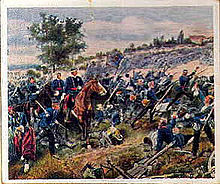|
XIII (Royal Württemberg) Corps
 The XIII (Royal Württemberg) Army Corps / XIII AK (German: XIII. (Königlich Württembergisches) Armee-Korps) was a corps of the Imperial German Army. It was, effectively, also the army of the Kingdom of Württemberg, which had been integrated in 1871 into the Prussian Army command structure, as had the armies of most German states. The corps was originally established as the Württemberg Corps Command (Korpskommando) in 1817. It became the XIII Army Corps when it was integrated into the Prussian numbering system on December 18, 1871, shortly after the Franco-Prussian War.[1] Austro-Prussian WarThe corps saw action in the 1866 Austro-Prussian War, on the losing Austrian side, as the Royal Württemberg Division of the VIII German Federation Army Corps (VIII. deutschen Bundesarmeekorps). It was unable to stop a Prussian advance into north Württemberg at Tauberbischofsheim, but this battle was not important in the war. Franco-Prussian WarIn the Franco-Prussian War of 1870-71, the corps served under the headquarters staff of the Württemberg Field Division of the Combined Württemberg-Baden Army Corps. The Württemberg Field Division saw action in the battles of Wörth and Sedan, and in the Siege of Paris. Peacetime organisationThe corps' two divisions were the 26th and 27th. The 25 peacetime Corps of the German Army (Guards, I - XXI, I - III Bavarian) had a reasonably standardised organisation. Each consisted of two divisions with usually two infantry brigades, one field artillery brigade and a cavalry brigade each.[2] Each brigade normally consisted of two regiments of the appropriate type, so each Corps normally commanded 8 infantry, 4 field artillery and 4 cavalry regiments. There were exceptions to this rule:
Each Corps also directly controlled a number of other units. This could include one or more In addition, the 126th (8th Württemberg) Infantry "Grand Duke Frederick of Baden" was stationed at Straßburg as part of XV Corps. World War IOrganisation on mobilisationOn mobilization on August 2, 1914 the Corps was restructured. The 180th Infantry Regiment was assigned to the 26th Reserve Division in XIV Reserve Corps. The 26th Cavalry Brigade was withdrawn to form part of the 7th Cavalry Division[5] and the 27th Cavalry Brigade was broken up and its regiments assigned as reconnaissance units to the divisions. The two divisions received engineer companies and other support units from the Corps headquarters. In summary, XIII Corps mobilised with 24 infantry battalions, 8 machine gun companies (48 machine guns), 8 cavalry squadrons, 24 field artillery batteries (144 guns), 4 heavy artillery batteries (16 guns), 3 pioneer companies and an aviation detachment.
Combat chronicleOn mobilization in 1914, the corps was subordinated to the 5th Army and saw action on the Western Front. It was transferred to the 6th Army during the Race to the Sea. In October 1914, the corps headquarters formed Corps Fabeck, which by the end of the month had become a provisional army group, commanding XV Corps, II Bavarian Corps and Corps Urach. In November, the XIII Army Corps was transferred from the 6th Army to the 9th Army on the Eastern Front. By 1916, the corps had returned to the Western Front and was subordinated to the 4th Army under Army Group Crown Prince Rupprecht. From April 1917 to March 1918, the corps commanded Group Caudry, another provisional command. In September 1918, it took over command of Group Ebene under Army Group Duke Albrecht of Württemberg, and commanded Group Ebene until war's end.[8] It was still in existence at the end of the war[9] in Armee-Abteilung C, Heeresgruppe Gallwitz on the Western Front.[10] Württemberg mountain battalionIn 1915, drafts from the Württemberg line regiments were used to form a Württemberg mountain battalion, which became a part of the Alpenkorps division in 1917. This was the unit in which the young Erwin Rommel distinguished himself on the Romanian and Italian fronts, winning the Pour le Mérite (Imperial German equivalent of the Victoria Cross) at the Battle of the Isonzo in 1917. CommandersThe XIII Corps had the following commanders during its existence:[11][12][13]
See also
References
Bibliography
|
|||||||||||||||||||||||||||||||||||||||||||||||||||||||||||||||||||||||||||||||||||||||||||||||||||||||||||||||||||||
Portal di Ensiklopedia Dunia
